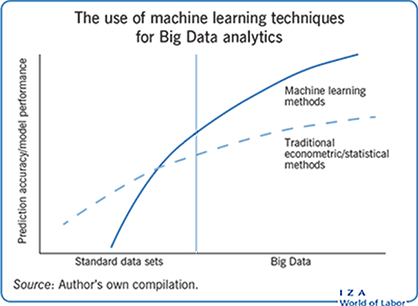Elevator pitch
Big Data refers to data sets of much larger size, higher frequency, and often more personalized information. Examples include data collected by smart sensors in homes or aggregation of tweets on Twitter. In small data sets, traditional econometric methods tend to outperform more complex techniques. In large data sets, however, machine learning methods shine. New analytic approaches are needed to make the most of Big Data in economics. Researchers and policymakers should thus pay close attention to recent developments in machine learning techniques if they want to fully take advantage of these new sources of Big Data.

Key findings
Pros
Complex data are now available, characterized by large volume, fast velocity, diverse varieties, and the ability to link many data sets together.
Powerful new analytic techniques derived from machine learning are increasingly part of the mainstream econometric toolbox.
Big Data allows for better prediction of economic phenomena and improves causal inference.
Machine learning techniques allow researchers to create simple models that describe very large, complex data sets.
Machine learning methods and Big Data also allow for the complex modeling of relationships that predict well beyond the sample.
Cons
Predictions based on Big Data may have privacy concerns.
Machine learning methods are computationally intensive, may not have unique solutions, and may require a high degree of fine tuning for optimal performance.
Big Data is costly to collect and store, and analyzing it requires investments in technology and human skill.
Big Data may suffer from selection bias depending on how and by whom data are being generated.
Access to these data may involve partnering with firms who limit researcher freedom.